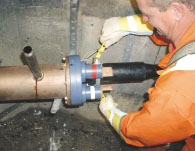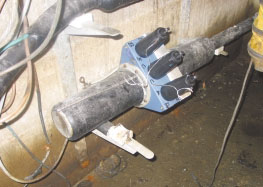In spite of all the rhetoric about “getting the lead out”, most larger North American urban centers are still maintaining some form of medium voltage underground network power distribution system using paper insulated, lead covered (PILC) cables. The introduction of these types of cables goes back to the 1930’s, making some of the first cables produced over 70 years old. Many of these cables are still directly connected to their original oil-insulated switchgear and protective devices and continue to give excellent service with minimal maintenance, provided they remain undisturbed.
Most incidences of problems with these older “oil-impregnated” cables occur when they are “disturbed”. Routine maintenance, the addition of new connections and new construction puts additional mechanical or electrical stresses on these aging system components. In locations where cables are exposed to the weather, stress fractures in the lead jackets are becoming a significant problem. A breech in the integrity of the lead jacket will allow moisture into the cable resulting in rapid degradation of the cable insulation. As older systems are increasingly pushed beyond their original design operating limits, higher cable temperatures can begin to force oil out of the paper insulation drastically reducing its dielectric strength. On inclined installations, head and tail pressure differences can drain oil from the top of a cable while the lead at the bottom of the cable may swell due to the increased pressures. This will inevitably lead to oil leaks. Replacing the PILC cable entirely with its dry dielectric counterpart would be the ideal solution however, the costs, service disruptions, and logistics involved are forcing utilities to consider maintaining existing installations far longer than their original “get the lead out” schedule mandated.
When the decision is made to remove a section of PILC cable, there are a variety of splicing methods available. Unfortunately the skills necessary to do this type of work are not always being retained by many of the companies with PILC cables on their systems. Some utilities have training facilities in place to maintain and upgrade their personnel skill levels. Others are relying on private companies to provide the expertise when necessary. Despite the decreasing number of skilled workers available, splicing PILC cable to dry dielectric cable often remains the best and/or only alternative to replacing the PILC cable in its entirety.
The most common methods of splicing PILC cable are: heat shrink tubing, cold shrink tubing or vacuum cast, silica sand filled thermal setting resin transition modules. Of these methods, each has its own benefits and drawbacks. Heat shrink components are relatively easy to install but often there isn’t room available to get the heat source directed completely around the tubes and uneven shrinkage may result in improper sealing. Cold shrink components may be more convenient at times but there is not always the space available to easily position the tubes for core removal and the proper application of restricting tapes may be difficult. Vacuum cast, silica sand filled thermal setting resin transition modules are highly reliable. It is unfortunate that in crowded manholes there can be a problem providing the necessary cable length for installing wiping sleeves and cable tray clearances can prevent the use of separable insulated connectors. If neither of these restrictions exists and properly trained personnel are available to do the taping, soldering, wiping and compound pouring, it’s hard to beat the reliability and convenience of a vacuum cast resin transition splice.
With shrink tubing splices it is common to have to run the spliced in cross-linked polyethylene (XLPE) or ethylene propylene rubber (EPR) cables to a separate location to make junction bar connections. Often manholes or vaults are already crowded and cannot accept the addition of a splice, junction bars and all the resultant cable connections. The greatest advantage of the transition module design is the combination of barrier and junction bar in one device, allowing the connection of separable insulated connector elbows right at the splice.
PILC cables are often terminated within oil-filled devices by a variety of methods, but generally through a top or bottom entry wiping sleeve. A bottom entry cable presents a “silent” risk for oil-filled devices as it is possible for the oil within the termination chamber to actually migrate within the PILC cable and slowly drain oil from the termination chamber, eventually leading to internal flashover. If the decision is to replace a PILC cable with XLPE or EPR cable, there may be a problem with making the connection to the existing oil-filled connection box. Vacuum cast, silica sand filled thermal setting resin products designed specifically for this type of transitional connection are readily available with a minimal amount of lead time.
For at least the last 10 years the EPA has been asking utilities to get PILC cable out of the ground as soon as possible. There are many problems to be dealt with when deciding to remove PILC type cables. Often the original ducts have shifted or been crushed and the cable is jammed inside. The cable may have bends within the ducting which will not easily straighten out when being pulled. Most often the PILC cable diameter is such that even with removal from the duct, many replacement cables are too large to be installed in the old duct. New cables are now available that are designed specifically to fit inside old ducts. Today, specialized techniques to remove cables from ducts have been developed by a number of companies and cables previously considered lost forever are being removed and recycled. Regardless, this is not an easy or short term program and requires the allocation of enormous financial and labor resources to achieve. Any work being done on urban distribution systems means extensive and lengthy interruptions to traffic flow, possibly major renovations to existing electrical installations, removal of old cables and installation of new cables, much of which may require completely new ducting, all in the center of a city. As most of the installed PILC cables are not exhibiting signs of degradation and they are inside ducting, the lead and oil in these cables is temporarily contained. There are a large number of companies able to properly dispose of scrapped PILC cable but from the time it comes out of the ground to its final disposal, it becomes a highly visible and hazardous environmental concern.
Even though all utilities are in a conscious mode of trying to remove lead cable from their system, it is going to be a long time before the work is complete. It’s very likely that “getting the lead out” has moved a notch or two down many utilities priorities scale. It is also highly probable that there will still be PILC cable in use in North America in the next century.

Most incidences of problems with these older “oil-impregnated” cables occur when they are “disturbed”. Routine maintenance, the addition of new connections and new construction puts additional mechanical or electrical stresses on these aging system components. In locations where cables are exposed to the weather, stress fractures in the lead jackets are becoming a significant problem. A breech in the integrity of the lead jacket will allow moisture into the cable resulting in rapid degradation of the cable insulation. As older systems are increasingly pushed beyond their original design operating limits, higher cable temperatures can begin to force oil out of the paper insulation drastically reducing its dielectric strength. On inclined installations, head and tail pressure differences can drain oil from the top of a cable while the lead at the bottom of the cable may swell due to the increased pressures. This will inevitably lead to oil leaks. Replacing the PILC cable entirely with its dry dielectric counterpart would be the ideal solution however, the costs, service disruptions, and logistics involved are forcing utilities to consider maintaining existing installations far longer than their original “get the lead out” schedule mandated.
When the decision is made to remove a section of PILC cable, there are a variety of splicing methods available. Unfortunately the skills necessary to do this type of work are not always being retained by many of the companies with PILC cables on their systems. Some utilities have training facilities in place to maintain and upgrade their personnel skill levels. Others are relying on private companies to provide the expertise when necessary. Despite the decreasing number of skilled workers available, splicing PILC cable to dry dielectric cable often remains the best and/or only alternative to replacing the PILC cable in its entirety.

The most common methods of splicing PILC cable are: heat shrink tubing, cold shrink tubing or vacuum cast, silica sand filled thermal setting resin transition modules. Of these methods, each has its own benefits and drawbacks. Heat shrink components are relatively easy to install but often there isn’t room available to get the heat source directed completely around the tubes and uneven shrinkage may result in improper sealing. Cold shrink components may be more convenient at times but there is not always the space available to easily position the tubes for core removal and the proper application of restricting tapes may be difficult. Vacuum cast, silica sand filled thermal setting resin transition modules are highly reliable. It is unfortunate that in crowded manholes there can be a problem providing the necessary cable length for installing wiping sleeves and cable tray clearances can prevent the use of separable insulated connectors. If neither of these restrictions exists and properly trained personnel are available to do the taping, soldering, wiping and compound pouring, it’s hard to beat the reliability and convenience of a vacuum cast resin transition splice.
With shrink tubing splices it is common to have to run the spliced in cross-linked polyethylene (XLPE) or ethylene propylene rubber (EPR) cables to a separate location to make junction bar connections. Often manholes or vaults are already crowded and cannot accept the addition of a splice, junction bars and all the resultant cable connections. The greatest advantage of the transition module design is the combination of barrier and junction bar in one device, allowing the connection of separable insulated connector elbows right at the splice.
PILC cables are often terminated within oil-filled devices by a variety of methods, but generally through a top or bottom entry wiping sleeve. A bottom entry cable presents a “silent” risk for oil-filled devices as it is possible for the oil within the termination chamber to actually migrate within the PILC cable and slowly drain oil from the termination chamber, eventually leading to internal flashover. If the decision is to replace a PILC cable with XLPE or EPR cable, there may be a problem with making the connection to the existing oil-filled connection box. Vacuum cast, silica sand filled thermal setting resin products designed specifically for this type of transitional connection are readily available with a minimal amount of lead time.
For at least the last 10 years the EPA has been asking utilities to get PILC cable out of the ground as soon as possible. There are many problems to be dealt with when deciding to remove PILC type cables. Often the original ducts have shifted or been crushed and the cable is jammed inside. The cable may have bends within the ducting which will not easily straighten out when being pulled. Most often the PILC cable diameter is such that even with removal from the duct, many replacement cables are too large to be installed in the old duct. New cables are now available that are designed specifically to fit inside old ducts. Today, specialized techniques to remove cables from ducts have been developed by a number of companies and cables previously considered lost forever are being removed and recycled. Regardless, this is not an easy or short term program and requires the allocation of enormous financial and labor resources to achieve. Any work being done on urban distribution systems means extensive and lengthy interruptions to traffic flow, possibly major renovations to existing electrical installations, removal of old cables and installation of new cables, much of which may require completely new ducting, all in the center of a city. As most of the installed PILC cables are not exhibiting signs of degradation and they are inside ducting, the lead and oil in these cables is temporarily contained. There are a large number of companies able to properly dispose of scrapped PILC cable but from the time it comes out of the ground to its final disposal, it becomes a highly visible and hazardous environmental concern.
Even though all utilities are in a conscious mode of trying to remove lead cable from their system, it is going to be a long time before the work is complete. It’s very likely that “getting the lead out” has moved a notch or two down many utilities priorities scale. It is also highly probable that there will still be PILC cable in use in North America in the next century.









